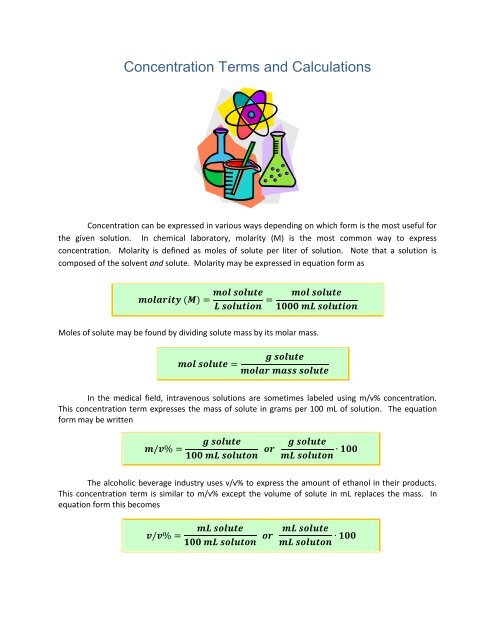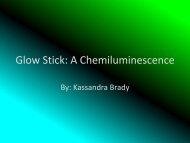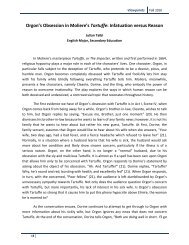Concentration Terms and Calculations - Quantum
Concentration Terms and Calculations - Quantum
Concentration Terms and Calculations - Quantum
Create successful ePaper yourself
Turn your PDF publications into a flip-book with our unique Google optimized e-Paper software.
<strong>Concentration</strong> <strong>Terms</strong> <strong>and</strong> <strong>Calculations</strong><strong>Concentration</strong> can be expressed in various ways depending on which form is the most useful forthe given solution. In chemical laboratory, molarity (M) is the most common way to expressconcentration. Molarity is defined as moles of solute per liter of solution. Note that a solution iscomposed of the solvent <strong>and</strong> solute. Molarity may be expressed in equation form asMoles of solute may be found by dividing solute mass by its molar mass.In the medical field, intravenous solutions are sometimes labeled using m/v% concentration.This concentration term expresses the mass of solute in grams per 100 mL of solution. The equationform may be writtenThe alcoholic beverage industry uses v/v% to express the amount of ethanol in their products.This concentration term is similar to m/v% except the volume of solute in mL replaces the mass. Inequation form this becomes
In the case of environmental pollution, much smaller concentration terms are needed. Two ofthe most common ones are parts per million (ppm) <strong>and</strong> parts per billion (ppb). Both terms express theamount of solute per million or billion parts of solution. The solute units <strong>and</strong> solvent units must beidentical when doing the calculation.If the solvent is water <strong>and</strong> parts are grams, ppm may be redefined in mass/volume units by using 1.00g/mL for the density of a dilute aqueous solution.Similarly, ppb becomes µg solute/L solution by substituting 10 9 for 10 6 <strong>and</strong> 10 6 µg for 1000 mg in theabove equation.How to calculate the molarity of a solution from m/v%The normal level of glucose in the blood usually averages 100. mg/100. mL. Calculate the averagemolarity of glucose in blood.Solution:Write down the given values with theirunits <strong>and</strong> what they represent.In this problem, mg/v% is given for the solute glucose <strong>and</strong>the solvent blood. The chemical formula for glucose isC 6 H 12 O 6 . The molar masses of C, H, <strong>and</strong> O can be obtainedfrom the Periodic Table.mg/v% = 100. mg glucose/100. mL blood1 mol C = 12.01 g/mol1 mol O = 16.00 g/mol1 mol H – 1.008 g/molmolar mass glucose = 180.16 g/mol
Write down the unknown <strong>and</strong> its unit.The molarity of the glucose in blood is unknown.M glucose = ?Develop a strategy to solve the problem.The definition of molarity isA dimensional analysis problem is set up to give molglucose/L blood.Round off the answer to the correctnumber of significant digits <strong>and</strong> give theappropriate units.The mg/v% has 3 significant digits while the molar mass has5. The molarity is rounded off to 3 significant digits. Theconversion factors for mg <strong>and</strong> mL are metric definitions <strong>and</strong>do not affect the number of significant digits in the answer.The answer isM = 0.00555 M glucose or 5.55 x 10 -3 M glucoseCheck whether the answer is reasonable.The mass of C 6 H 12 O 6 is 0.0005 the molar mass of glucosein 0.1 L of blood; the answer is reasonable.How to calculate the m/v% of a solution from molarityA certain pre-mixed antifreeze solution is 8.45 M ethylene glycol. What is the m/v% for ethylene glycolin this mixture?
Solution:Write down the given values with theirunits <strong>and</strong> what they represent.In this problem, molarity is given for the solute ethyleneglycol <strong>and</strong> the solvent water. The chemical formula forethylene glycol is C 2 H 6 O 2 . The molar masses of C, H, <strong>and</strong> Ocan be obtained from the Periodic Table.mg/v% = 100. mg glucose/100. mL blood1 mol C = 12.01 g/mol1 mol O = 16.00 g/mol1 mol H = 1.008 g/molmolar mass ethylene glycol = 62.07 g/molWrite down the unknown <strong>and</strong> its unit.The m/v% of ethylene glycol in antifreeze is unknown.m/v% ethylene glycol = ?Develop a strategy to solve the problem.The definition of m/v% isA dimensional analysis problem is set up to give gC 2 H 6 O 2 /100 mL antifreeze.Round off the answer to the correctnumber of significant digits <strong>and</strong> give theappropriate units.The molarity has 3 significant digits while the molar masshas 4. The m/v% is rounded off to 3 significant digits. Theanswer ism/v% = 52.4 m/v% ethylene glycolCheck whether the answer is reasonable.The moles of C 2 H 6 O 2 in 100 mL is 0.1 that in a liter. Themass of C 2 H 6 O 2 in 100 mL antifreeze is 0.8 its molar mass;the answer is reasonable.
How to calculate grams of solute needed to make a solutionThe average molarity of sucrose in (C 12 H 22 O 11 ) in a soft drink can (355 mL) is 0.37 M. Calculate theaverage grams of sucrose needed per can of soft drink.Solution:Write down the given values withtheir units <strong>and</strong> what they represent.In this problem, molarity is given for the solute sucrose <strong>and</strong> thesolvent water. The chemical formula for sucrose is C 12 H 22 O 11 . Themolar masses of C, H, <strong>and</strong> O can be obtained from the PeriodicTable.M sucrose = 0.37 mol sucrose/L sodaV soda = 355 mL1 mol C = 12.01 g/mol;1 mol O = 16.00 g/mol1 mol H – 1.008 g/molmolar mass sucrose = 342.30 g/molWrite down the unknown <strong>and</strong> itsunit.Develop a strategy to solve theproblem.The grams of sucrose in a soda can is unknown.The definition of molarity isg sucrose = ?A dimensional analysis problem is set up to give g sucrose in 355mL soda.Round off the answer to the correctnumber of significant digits <strong>and</strong> givethe appropriate units.The molarity has 2 significant digits while the volume has 3 <strong>and</strong>molar mass 5. The mass is rounded off to 2 significant digits. Theanswer ismass = 45 g sucrose
Check whether the answer isreasonable.The volume of a soda can is 1/3 L. 0.1 moles of sucrose isneeded; the answer is reasonable.How to calculate grams of solute in a given volume of solutionA physiological saline solution is 0.154 M NaCl. How many grams of sodium chloride are in 500. mL ofthe solution?Solution:Write down the given values with theirunits <strong>and</strong> what they represent.In this problem, molarity is given for the solute NaCl <strong>and</strong>the solvent water. The molar masses of Na <strong>and</strong> Cl can beobtained from the Periodic Table.M NaCl = 0..154 mol NaCl/L salineV saline = 500. mL1 mol Na = 22.99 g/mol1 mol Cl = 35.45g/molmolar mass NaCl = 58.44 g/molWrite down the unknown <strong>and</strong> its unit.The grams of NaCl in 500. mL of saline is unknown.g NaCl = ?Develop a strategy to solve the problem.The definition of molarity isA dimensional analysis problem is set up to give g NaCl in500. mL saline.
Round off the answer to the correctnumber of significant digits <strong>and</strong> give theappropriate units.The molarity <strong>and</strong> volume saline have 3 significant digitswhile the molar mass has 4. The mass is rounded off to 3significant digits. The answer ismass = 4.50 g NaClCheck whether the answer is reasonable.The volume of saline is 0.5 L. 0.075 moles of NaCl wouldbe present; the answer is reasonable.








